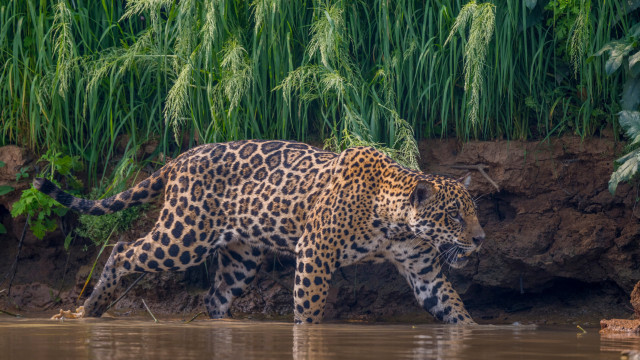






























See Also
See Again
© Getty Images
0 / 31 Fotos
Ancient partnership
- Humans have bonded with animals since prehistoric times. These early relationships weren’t just for survival; they laid the groundwork for emotional connections, with some animals eventually becoming trusted companions and not just tools or food sources.
© Getty Images
1 / 31 Fotos
Evolutionary advantage
- Caring for animals offered practical benefits in early societies, improving survival rates and cooperation. Groups that empathized with animals thrived, and they passed along this emotional trait that still influences how we relate to pets today.
© Getty Images
2 / 31 Fotos
From wild beasts to best friends
- Domestication began when early humans formed friendly relationships with certain animals. By treating them as companions rather than food, humans helped create today's pet species, whose ancestors were chosen for their tameness and sociability.
© Getty Images
3 / 31 Fotos
In our genes
- Research suggests a genetic basis for loving animals. Some people naturally gravitate toward pets, while others don't. This inherited tendency might trace back to evolutionary advantages associated with taming and coexisting with animals.
© Getty Images
4 / 31 Fotos
Biophilia
- Humans may be hardwired to love nature and living things. The biophilia hypothesis suggests we have an inborn tendency to connect with animals and nature, since it offers emotional balance in increasingly artificial environments.
© Shutterstock
5 / 31 Fotos
Reconnecting with nature
- Modern life can disconnect us from the natural world. Pets act as daily reminders of life beyond technology, nurturing a sense of environmental awareness and grounding us in cycles of nature and emotional well-being.
© Shutterstock
6 / 31 Fotos
Caregiving instincts
- Animal features that resemble human babies (such as big eyes or small noses) activate our natural caregiving responses. This “baby schema” encourages us to nurture and protect animals, especially those with cute, vulnerable appearances.
© Getty Images
7 / 31 Fotos
The bonding brain hormone
- Interacting with pets boosts oxytocin levels, the hormone responsible for bonding and love. This chemical connection mirrors what we feel with family, and deepens the emotional ties between people and their beloved animals.
© Shutterstock
8 / 31 Fotos
The brain’s reward centers
- Brain scans show that seeing our pets activates emotional and reward centers, much like seeing a loved one. This neurological response reinforces affection, making time spent with pets emotionally gratifying and deeply fulfilling.
© Getty Images
9 / 31 Fotos
Health and happiness boosters
- But pets provide more than companionship. They are actually proven to help reduce stress, improve mood, and promote better health. Their presence encourages routines, offers emotional support, and enhances our mental well-being in tangible and lasting ways.
© Shutterstock
10 / 31 Fotos
Empathy and compassionate hearts
- Animal lovers often score high on empathy when it comes to psychological evaluations, since they have a tendency to show strong concern for the feelings and welfare of others. This compassionate mindset extends naturally to animals, driving their desire to nurture, protect, and emotionally connect.
© Shutterstock
11 / 31 Fotos
Childhood bonds
- Positive childhood experiences with pets often shape lifelong love for animals. Kids raised with pets learn empathy and connection, while those with limited exposure or traumatic encounters may develop indifference or even fear.
© Getty Images
12 / 31 Fotos
The hierarchy of humanity
- Loving pet owners often assign human traits to animals—talking to them, interpreting emotions, or treating them like family. Experts believe that those who vehemently dislike animals oftentimes enforce a hierarchy where animals are seen as lesser than and not equal to humans.
© Getty Images
13 / 31 Fotos
Dogs vs. cats
- Dog lovers tend to be outgoing and structured, while cat lovers lean toward independence and creativity. Personality traits often influence which animal people connect with more, which can explain differences in preferences and affections.
© Getty Images
14 / 31 Fotos
Cute vs. creepy
- The level of a person’s affection toward animals also verily depends on appearance and instinct. Mammals with soft features are seen as cute, while reptiles or insects may trigger fear or disgust due to deep-rooted evolutionary responses designed to protect us.
© Getty Images
15 / 31 Fotos
A matter of culture
- In some cultures, pet-keeping is rare or viewed differently. While Western societies often humanize pets, others see animals mainly as workers or resources. Cultural context strongly shapes whether animals are loved or merely tolerated.
© Getty Images
16 / 31 Fotos
Animals in religion and spirituality
- Religious beliefs often influence how animals are viewed. Some cultures (such as indigenous Americans and Hindus) revere them as sacred, while others stress human superiority. These views can foster deep respect and love, or create emotional distance from animals altogether.
© Getty Images
17 / 31 Fotos
Food or pests
- Animals treated as food or nuisances are harder to love emotionally. Cultural roles (such as livestock, pests, or laborers) often prevent people from forming bonds with animals, as affection may conflict with practical or utilitarian perspectives.
© Shutterstock
18 / 31 Fotos
Modern pet parenthood
- Today, pets are more pampered than ever. With fewer children and more emotional space, people increasingly treat pets like kids. This modern view amplifies love and reshapes how society sees the human-animal bond.
© Shutterstock
19 / 31 Fotos
Fur babies
- Many people go so far as to treat their pets like children, integrating them fully into family life. These so-called “fur babies” receive love, celebration, and care equal to human members.
© Getty Images
20 / 31 Fotos
Lack of exposure
- Many people who don’t love animals simply never had the chance to bond with them. Without early positive experiences, animals remain unfamiliar or irrelevant, which makes emotional connection less likely to develop over time.
© Shutterstock
21 / 31 Fotos
Traumatic experiences and fears
- Fear stemming from bites, attacks, or losses can also create lifelong aversion to animals. Negative early experiences often override curiosity or empathy, making it hard to trust, much less love, the animals that once caused pain.
© Shutterstock
22 / 31 Fotos
Time, money, and responsibility
- Some people avoid pet ownership not out of dislike, but due to the effort involved. Pets require time, care, and finances—barriers that may lead people to appreciate animals from afar while avoiding the commitment of ownership.
© Shutterstock
23 / 31 Fotos
Dirty or dangerous
- Misunderstandings about cleanliness or safety often keep people from bonding with animals. The belief that pets spread disease or act unpredictably can create emotional distance, especially if this belief is reinforced by culture, upbringing, or media.
© Shutterstock
24 / 31 Fotos
Personality types
- Certain personality traits (like dominance, materialism, or lack of empathy) may make people less inclined to love animals. Some individuals simply don’t find emotional fulfillment in animal relationships and prioritize control, logic, or human connections instead.
© Shutterstock
25 / 31 Fotos
Preferring human connections
- Not everyone needs or wants emotional ties with animals. Some prioritize relationships with people and see animals as unnecessary. Their affection stays human-focused, often due to personal values or upbringing.
© Shutterstock
26 / 31 Fotos
Social and cultural pressures
- Social environments shape whether loving animals is encouraged or seen as odd. Some people downplay affection due to fear of judgment or peer norms, even if they secretly enjoy animal companionship or admiration.
© Shutterstock
27 / 31 Fotos
Ethical views and moral dilemmas
- Moral beliefs can also affect how people relate to animals. Some avoid loving animals to focus on human welfare, while others feel conflicted over eating meat yet loving pets. Ethical reasoning around animals can dampen or redirect affection.
© Getty Images
28 / 31 Fotos
Cruelty and pathology
- In rare cases, people lack empathy entirely and may even harm animals. These pathological personalities don’t form emotional bonds and may see animals as tools or threats, not companions worthy of care or love.
© Shutterstock
29 / 31 Fotos
Nature and nurture
- Animal affection lies on a spectrum shaped by genetics, upbringing, culture, and personality. While some people deeply bond with animals, others feel indifferent. Neither is wrong, and it simply reflects the complex nature of emotional connection. Sources: (The Conversation) (The Independent) (Britannica) (National Institutes of Health) (Neuroscience News) (Animal Lovers Network) (CBS News) See also: The challenges of traveling with pets
© Shutterstock
30 / 31 Fotos
© Getty Images
0 / 31 Fotos
Ancient partnership
- Humans have bonded with animals since prehistoric times. These early relationships weren’t just for survival; they laid the groundwork for emotional connections, with some animals eventually becoming trusted companions and not just tools or food sources.
© Getty Images
1 / 31 Fotos
Evolutionary advantage
- Caring for animals offered practical benefits in early societies, improving survival rates and cooperation. Groups that empathized with animals thrived, and they passed along this emotional trait that still influences how we relate to pets today.
© Getty Images
2 / 31 Fotos
From wild beasts to best friends
- Domestication began when early humans formed friendly relationships with certain animals. By treating them as companions rather than food, humans helped create today's pet species, whose ancestors were chosen for their tameness and sociability.
© Getty Images
3 / 31 Fotos
In our genes
- Research suggests a genetic basis for loving animals. Some people naturally gravitate toward pets, while others don't. This inherited tendency might trace back to evolutionary advantages associated with taming and coexisting with animals.
© Getty Images
4 / 31 Fotos
Biophilia
- Humans may be hardwired to love nature and living things. The biophilia hypothesis suggests we have an inborn tendency to connect with animals and nature, since it offers emotional balance in increasingly artificial environments.
© Shutterstock
5 / 31 Fotos
Reconnecting with nature
- Modern life can disconnect us from the natural world. Pets act as daily reminders of life beyond technology, nurturing a sense of environmental awareness and grounding us in cycles of nature and emotional well-being.
© Shutterstock
6 / 31 Fotos
Caregiving instincts
- Animal features that resemble human babies (such as big eyes or small noses) activate our natural caregiving responses. This “baby schema” encourages us to nurture and protect animals, especially those with cute, vulnerable appearances.
© Getty Images
7 / 31 Fotos
The bonding brain hormone
- Interacting with pets boosts oxytocin levels, the hormone responsible for bonding and love. This chemical connection mirrors what we feel with family, and deepens the emotional ties between people and their beloved animals.
© Shutterstock
8 / 31 Fotos
The brain’s reward centers
- Brain scans show that seeing our pets activates emotional and reward centers, much like seeing a loved one. This neurological response reinforces affection, making time spent with pets emotionally gratifying and deeply fulfilling.
© Getty Images
9 / 31 Fotos
Health and happiness boosters
- But pets provide more than companionship. They are actually proven to help reduce stress, improve mood, and promote better health. Their presence encourages routines, offers emotional support, and enhances our mental well-being in tangible and lasting ways.
© Shutterstock
10 / 31 Fotos
Empathy and compassionate hearts
- Animal lovers often score high on empathy when it comes to psychological evaluations, since they have a tendency to show strong concern for the feelings and welfare of others. This compassionate mindset extends naturally to animals, driving their desire to nurture, protect, and emotionally connect.
© Shutterstock
11 / 31 Fotos
Childhood bonds
- Positive childhood experiences with pets often shape lifelong love for animals. Kids raised with pets learn empathy and connection, while those with limited exposure or traumatic encounters may develop indifference or even fear.
© Getty Images
12 / 31 Fotos
The hierarchy of humanity
- Loving pet owners often assign human traits to animals—talking to them, interpreting emotions, or treating them like family. Experts believe that those who vehemently dislike animals oftentimes enforce a hierarchy where animals are seen as lesser than and not equal to humans.
© Getty Images
13 / 31 Fotos
Dogs vs. cats
- Dog lovers tend to be outgoing and structured, while cat lovers lean toward independence and creativity. Personality traits often influence which animal people connect with more, which can explain differences in preferences and affections.
© Getty Images
14 / 31 Fotos
Cute vs. creepy
- The level of a person’s affection toward animals also verily depends on appearance and instinct. Mammals with soft features are seen as cute, while reptiles or insects may trigger fear or disgust due to deep-rooted evolutionary responses designed to protect us.
© Getty Images
15 / 31 Fotos
A matter of culture
- In some cultures, pet-keeping is rare or viewed differently. While Western societies often humanize pets, others see animals mainly as workers or resources. Cultural context strongly shapes whether animals are loved or merely tolerated.
© Getty Images
16 / 31 Fotos
Animals in religion and spirituality
- Religious beliefs often influence how animals are viewed. Some cultures (such as indigenous Americans and Hindus) revere them as sacred, while others stress human superiority. These views can foster deep respect and love, or create emotional distance from animals altogether.
© Getty Images
17 / 31 Fotos
Food or pests
- Animals treated as food or nuisances are harder to love emotionally. Cultural roles (such as livestock, pests, or laborers) often prevent people from forming bonds with animals, as affection may conflict with practical or utilitarian perspectives.
© Shutterstock
18 / 31 Fotos
Modern pet parenthood
- Today, pets are more pampered than ever. With fewer children and more emotional space, people increasingly treat pets like kids. This modern view amplifies love and reshapes how society sees the human-animal bond.
© Shutterstock
19 / 31 Fotos
Fur babies
- Many people go so far as to treat their pets like children, integrating them fully into family life. These so-called “fur babies” receive love, celebration, and care equal to human members.
© Getty Images
20 / 31 Fotos
Lack of exposure
- Many people who don’t love animals simply never had the chance to bond with them. Without early positive experiences, animals remain unfamiliar or irrelevant, which makes emotional connection less likely to develop over time.
© Shutterstock
21 / 31 Fotos
Traumatic experiences and fears
- Fear stemming from bites, attacks, or losses can also create lifelong aversion to animals. Negative early experiences often override curiosity or empathy, making it hard to trust, much less love, the animals that once caused pain.
© Shutterstock
22 / 31 Fotos
Time, money, and responsibility
- Some people avoid pet ownership not out of dislike, but due to the effort involved. Pets require time, care, and finances—barriers that may lead people to appreciate animals from afar while avoiding the commitment of ownership.
© Shutterstock
23 / 31 Fotos
Dirty or dangerous
- Misunderstandings about cleanliness or safety often keep people from bonding with animals. The belief that pets spread disease or act unpredictably can create emotional distance, especially if this belief is reinforced by culture, upbringing, or media.
© Shutterstock
24 / 31 Fotos
Personality types
- Certain personality traits (like dominance, materialism, or lack of empathy) may make people less inclined to love animals. Some individuals simply don’t find emotional fulfillment in animal relationships and prioritize control, logic, or human connections instead.
© Shutterstock
25 / 31 Fotos
Preferring human connections
- Not everyone needs or wants emotional ties with animals. Some prioritize relationships with people and see animals as unnecessary. Their affection stays human-focused, often due to personal values or upbringing.
© Shutterstock
26 / 31 Fotos
Social and cultural pressures
- Social environments shape whether loving animals is encouraged or seen as odd. Some people downplay affection due to fear of judgment or peer norms, even if they secretly enjoy animal companionship or admiration.
© Shutterstock
27 / 31 Fotos
Ethical views and moral dilemmas
- Moral beliefs can also affect how people relate to animals. Some avoid loving animals to focus on human welfare, while others feel conflicted over eating meat yet loving pets. Ethical reasoning around animals can dampen or redirect affection.
© Getty Images
28 / 31 Fotos
Cruelty and pathology
- In rare cases, people lack empathy entirely and may even harm animals. These pathological personalities don’t form emotional bonds and may see animals as tools or threats, not companions worthy of care or love.
© Shutterstock
29 / 31 Fotos
Nature and nurture
- Animal affection lies on a spectrum shaped by genetics, upbringing, culture, and personality. While some people deeply bond with animals, others feel indifferent. Neither is wrong, and it simply reflects the complex nature of emotional connection. Sources: (The Conversation) (The Independent) (Britannica) (National Institutes of Health) (Neuroscience News) (Animal Lovers Network) (CBS News) See also: The challenges of traveling with pets
© Shutterstock
30 / 31 Fotos
Why some people love animals and others don’t, according to science
An emotional spectrum shaped by nature, nurture, and everything in between
© Getty Images
Whether it’s a wagging tail that warms your heart or a purring cat that makes you feel at home, the emotional bond many humans share with animals can run incredibly deep. For some, animals are more than companions: they’re family, therapists, and even soulmates. But for others, animals provoke indifference, discomfort, or even fear. What explains this vast difference in how people relate to the animal kingdom?
The answer lies in a fascinating blend of science, psychology, evolution, and culture. From the way our ancestors coexisted with animals to the hormones released when we cuddle a puppy, the reasons behind our feelings toward animals are as complex as they are compelling. Click through this gallery to find out the reasons why we feel the way we do about our furry, feathered, or scaled neighbors.
RECOMMENDED FOR YOU




































MOST READ
- Last Hour
- Last Day
- Last Week








